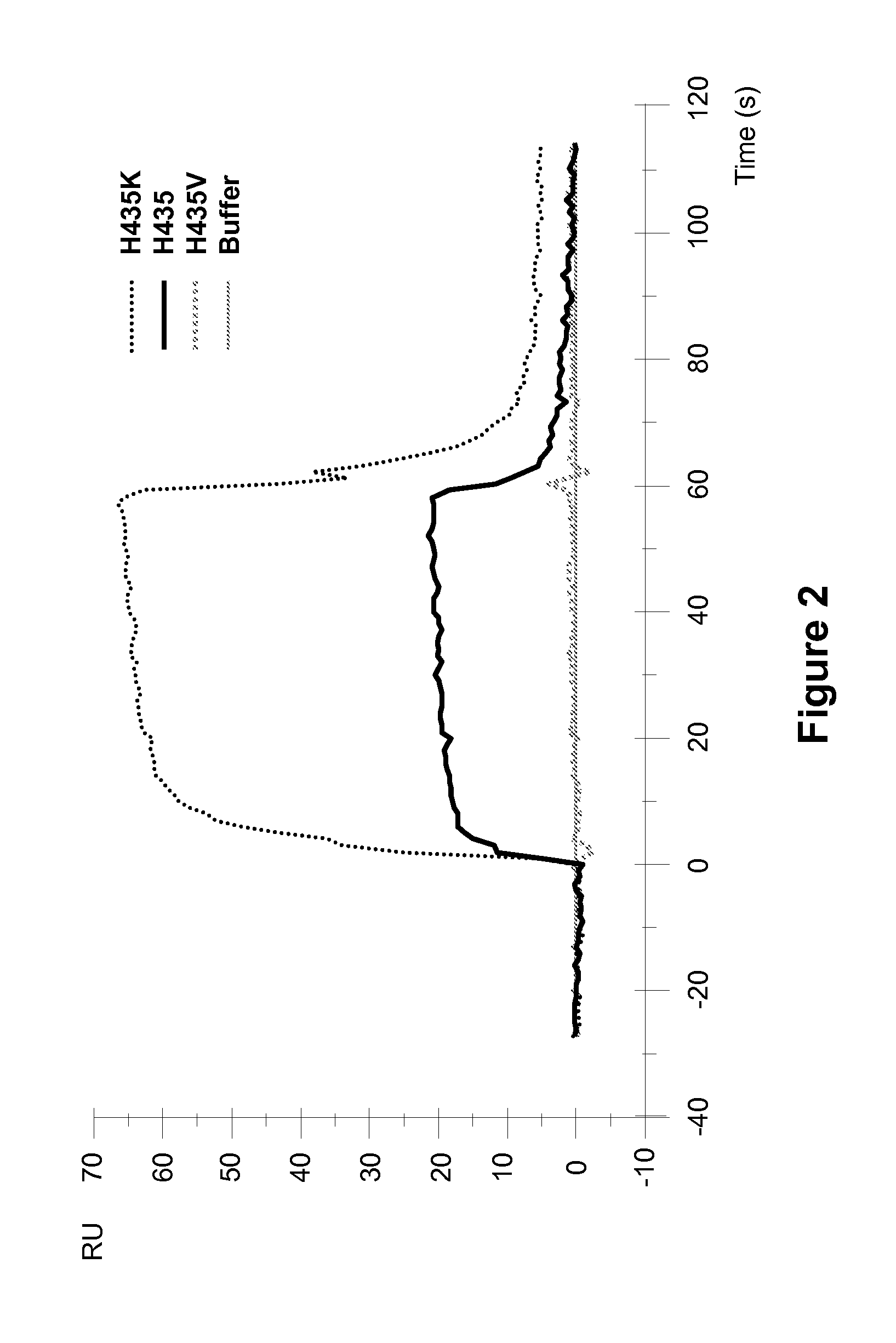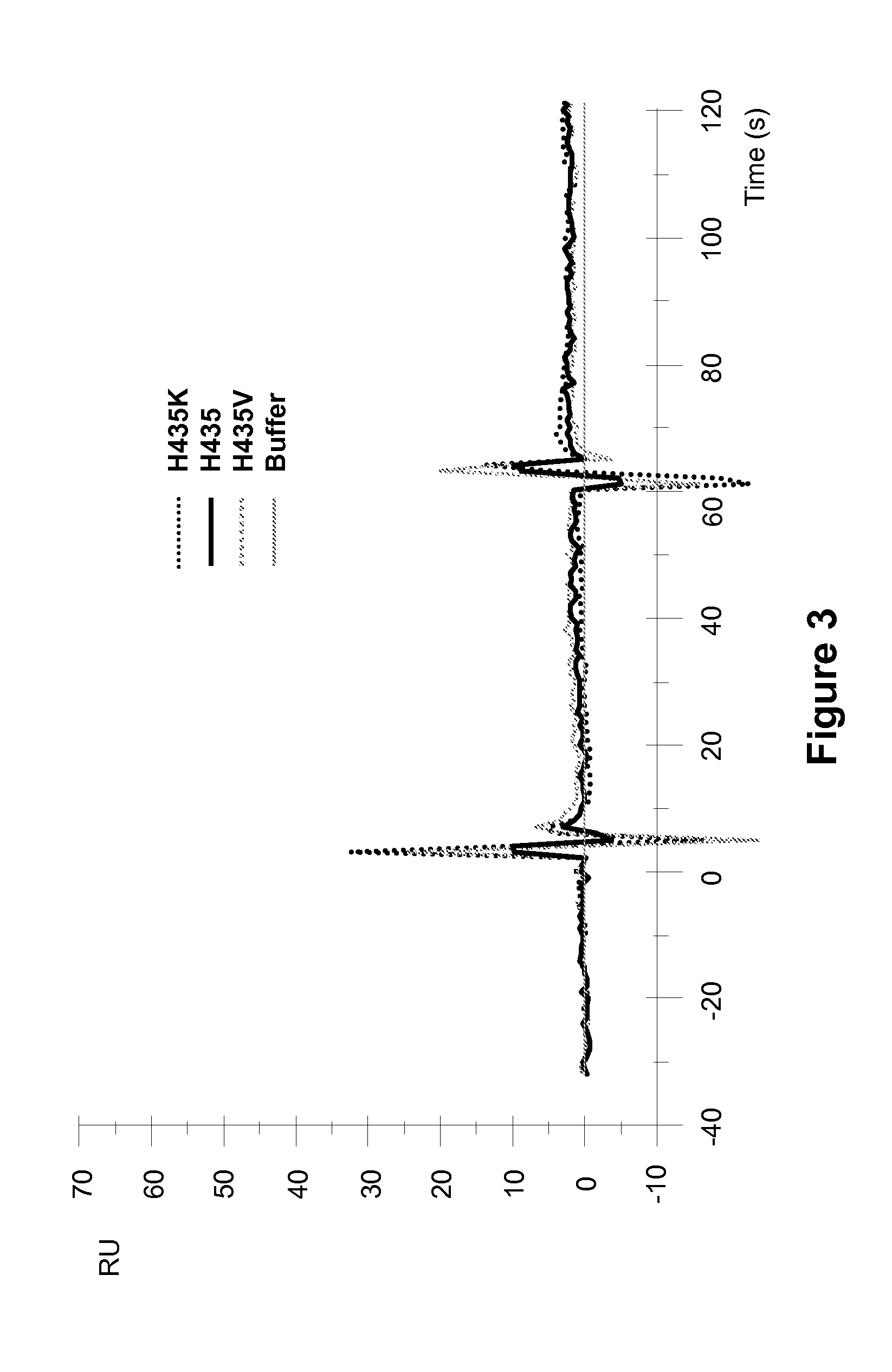Antibodies with Altered Binding to FcRn and Methods of Using Same
- Summary
- Abstract
- Description
- Claims
- Application Information
AI Technical Summary
Benefits of technology
Problems solved by technology
Method used
Image
Examples
example 1
[0256]Surface plasmon resonance analysis on a Biocore 3000 instrument was performed to analyze the effect of different amino acid substitutions at the position 435 of ch4420 on the binding to hFcRn. Changes in real time binding responses to hFcRn were analyzed comparatively to wild type Fc of ch4420 antibody which was captured on protein-FITC surface at the level about 500 RU. Three variants (H435K, H435R, and H435Q) and wild-type ch4420 antibodies were analyzed. Injection of supernatants containing ch4420 variants was followed by injection of hFcRn at concentration 500 nM in Na acetate buffer containing 150 mM NaCl and 0.005% P-20, pH 6.0 at flow rate 10 μl / min. The protein-FITC surface was regenerated by 10 mM Glycine pH 1.5 in between two different mutants. Results, shown in FIG. 1, indicate that mutant Fcs with substitutions of His to R and Q retained close to wild-type binding to hFcRn, but that the substitution of His to K significantly increased binding response (up to 4-fold...
example 2
[0257]Surface plasmon resonance analysis on a Biocore 3000 instrument was performed to analyze the effect of different amino acid substitutions at the position 435 of ch4420 on the pH dependency of hFcRn binding to mutant ch4420 captured on protein-FITC surface. pH dependency of binding to hFcRn was demonstrated in two separate experiments performed at similar conditions in sodium acetate buffer (pH 6.0) and HEPES buffer (pH 7.4). Injection of supernatants containing ch4420 variants was followed by injection of hFcRn at concentration 500 nM in 20 mM Na acetate buffer containing 150 mM NaCl and 0.005% P-20 pH 6.0 or 20 mM HEPES buffer containing 150 mM NaCl and 0.005% P-20 pH 7.4 at flow rate 10 μl / min. The protein-FITC surface was regenerated by 10 mM Glycine pH 1.5 between capturing of two different mutants. The buffer injection curve was subtracted as a blank. Results, shown in FIG. 2 and FIG. 3, indicate that mutant Fc with substitution of His to K exhibited enhanced binding to F...
example 3
[0258]Surface plasmon resonance analysis on a Biocore 3000 instrument was performed to analyze the effect of the H435K amino acid substitution in ch4420 on the binding to soluble human FcRn (shFcRn). Wild-type Fc and mutant Fc ch4420 antibodies were captured on the surface with immobilized mIgG1-Flrscn, and shFcRn was injected at concentration of 400 nM. Four variants (K288D, N434A, H435K, K288D and H435K), a YTE mutant (triple substitution of M252Y, S254T, and T256E; Dall'Acqua, W. F. et al. (2002) “Increasing The Affinity Of A Human Iggl For The Neonatal Fc Receptor: Biological Consequences,” J. Immunol. 169(9):5171-5180; Petkova, S. B. et al. (Epub 2006 Oct 31) “Enhanced Half-Life Of Genetically Engineered Human Iggl Antibodies In A Humanized Fcrn Mouse Model: Potential Application In Humorally Mediated Autoimmune Disease,” Int. Immunol. 18(12):1759-1769), and wild-type ch4420 antibodies were analyzed. FIG. 4 depicts an SPR analysis of binding of shFcRn (400 nM) to mutant Fc ch44...
PUM
| Property | Measurement | Unit |
|---|---|---|
| Current | aaaaa | aaaaa |
| Fraction | aaaaa | aaaaa |
| Length | aaaaa | aaaaa |
Abstract
Description
Claims
Application Information
 Login to View More
Login to View More - R&D
- Intellectual Property
- Life Sciences
- Materials
- Tech Scout
- Unparalleled Data Quality
- Higher Quality Content
- 60% Fewer Hallucinations
Browse by: Latest US Patents, China's latest patents, Technical Efficacy Thesaurus, Application Domain, Technology Topic, Popular Technical Reports.
© 2025 PatSnap. All rights reserved.Legal|Privacy policy|Modern Slavery Act Transparency Statement|Sitemap|About US| Contact US: help@patsnap.com



